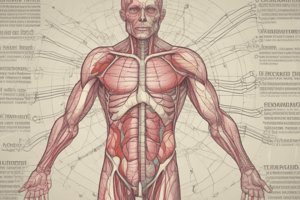Podcast
Questions and Answers
What is the name of the gland that is being discussed throughout the lecture?
What is the name of the gland that is being discussed throughout the lecture?
Pituitary gland
What are the two main parts of the pituitary gland?
What are the two main parts of the pituitary gland?
- Pars tuberalis and Pars intermedia
- Pars distalis and Pars tuberalis
- Pars nervosa and Pars intermedia
- Anterior pituitary and Posterior pituitary (correct)
What is the function of the acidophils and basophils in the pituitary gland?
What is the function of the acidophils and basophils in the pituitary gland?
Hormone secretion
Which part of the pituitary gland contains the infundibular stalk?
Which part of the pituitary gland contains the infundibular stalk?
The pars tuberalis is poorly vascularized.
The pars tuberalis is poorly vascularized.
The pars intermedia is known for being the location of Rathke's cysts.
The pars intermedia is known for being the location of Rathke's cysts.
Which of these cells are found in the pars nervosa?
Which of these cells are found in the pars nervosa?
What is the function of the hormone oxytocin?
What is the function of the hormone oxytocin?
What is the other name for vasopressin?
What is the other name for vasopressin?
The superior hypophyseal artery supplies blood to the anterior pituitary.
The superior hypophyseal artery supplies blood to the anterior pituitary.
Flashcards
Pars Distalis
Pars Distalis
The anterior lobe of the pituitary gland, composed of cords of cells and fenestrated capillaries.
Chromophils
Chromophils
Pituitary cells that contain granules and secrete hormones.
Chromophobes
Chromophobes
Pituitary cells that lack granules and are considered undifferentiated or reserve cells.
Acidophils
Acidophils
Signup and view all the flashcards
Basophils
Basophils
Signup and view all the flashcards
Somatotrophs
Somatotrophs
Signup and view all the flashcards
Mammotrophs
Mammotrophs
Signup and view all the flashcards
Thyrotrophs
Thyrotrophs
Signup and view all the flashcards
Corticotrophs
Corticotrophs
Signup and view all the flashcards
Gonadotrophs
Gonadotrophs
Signup and view all the flashcards
Pars Tuberalis
Pars Tuberalis
Signup and view all the flashcards
Pars Intermedia
Pars Intermedia
Signup and view all the flashcards
Pars Nervosa
Pars Nervosa
Signup and view all the flashcards
Oxytocin
Oxytocin
Signup and view all the flashcards
Vasopressin (ADH)
Vasopressin (ADH)
Signup and view all the flashcards
Study Notes
Pituitary Gland Overview
- The pituitary gland is a small endocrine gland located in the sella turcica of the sphenoid bone.
- It plays a crucial role in regulating various bodily functions.
Intended Learning Outcomes (ILOs)
- Students will learn to recognize the histological organization of the pituitary gland.
- Students will identify cells forming pars distalis.
- Students will discuss the structure and function of acidophils and basophils.
- The histological structure of pars tuberalis, pars intermedia, and pars nervosa will be described.
- Students will describe the blood supply of the pituitary gland.
Pituitary Gland Anatomy
- The pituitary gland has two main lobes: anterior and posterior.
- The anterior pituitary (adenohypophysis) develops from Rathke's pouch.
- The posterior pituitary (neurohypophysis) develops from the hypothalamus.
Pars Distalis
- This is the anterior pituitary lobe.
- It contains parenchyma (functional cells) and stroma (supporting tissue).
- Parenchyma includes chromophils (hormone-producing cells) and chromophobes (non-hormone producing cells).
- Acidophils (somatotrophs and mammotrophs) and basophils (thyrotrophs, corticotrophs, gonadotrophs) are further subdivisions of the chromophils.
Pars Tuberalis
- This region encircles the infundibulum.
- It has a highly vascular structure.
- Predominantly contains basophils and undifferentiated cells.
Pars Intermedia
- This region is poorly vascularized.
- Contains Rathke's cysts.
- Primary cells are corticotrophs (MSH producing cells).
Pars Nervosa
- This part of the posterior pituitary is rich in nerve fibers, lack myelination.
- Contains nerve fibers from the hypothalamus, Herring bodies and pituicytes.
- Functions: Oxytocin (paraventricular nucleus) targets the uterus and mammary gland. Vasopressin/ADH (supraoptic nucleus) regulates water reabsorption in the kidneys.
Blood Supply
- Pituitary blood supply is unique, featuring a hypothalamic-hypophyseal portal system. This system allows for direct delivery of hypothalamic hormones to the anterior pituitary.
Cell Types and Characteristics in Pars Distalis
| Cell Type | Percentage | Size | Granules | Function | Specific Stain |
|---|---|---|---|---|---|
| Acidophils | 48% | Larger | Present | Hormone secretion (e.g., growth hormone) | Orange G |
| Chromophobes | 52% | Smaller | Absent | Undifferentiated or exhausted chromophils | N/A |
| Basophils | Hormone secretion (e.g., TSH, ACTH) | PAS |
Acidophils Subtypes
| Cell Type | Percentage of Chromophils | Size | Function |
|---|---|---|---|
| Somatotrophs | 50% | Medium-sized | Growth hormone secretion |
| Mammotrophs | 15-20% | Large | Prolactin secretion (milk formation) |
Basophils Subtypes
| Cell Type | Percentage of Chromophils | Size | Function |
|---|---|---|---|
| Thyrotrophs | 5% | Large | TSH (thyroid-stimulating hormone) secretion |
| Corticotrophs | 15-20% | Medium-sized | ACTH (adrenocorticotropic hormone) secretion |
| Gonadotrophs | 10% | Small | FSH (follicle-stimulating hormone) / LH (male/female) secretion |
Studying That Suits You
Use AI to generate personalized quizzes and flashcards to suit your learning preferences.




